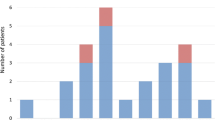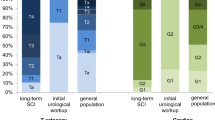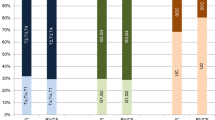Abstract
Purpose
Life expectancy for people with traumatic spinal cord injury (SCI) is increasing due to advances in treatment methods and in neuro-urology. Thus, developing urinary bladder cancer (UBC) is gaining importance.
Methods
Single-centre retrospective evaluation of consecutive in- and out-patient data with spinal cord injury between January 1st, 1998 and December 31st, 2018 was carried out and data were compared with UBC data of the German population from the German Centre for Cancer Registry Data at Robert Koch Institute.
Results
A total of 37 (4 female, 33 male) out of 7004 patients with SCI were diagnosed with histologically proven UBC (median follow-up 85 months). Median age at UBC diagnosis was 54.0 years (general population: 74 years). The SCI patients had significantly (p < 0.0001, each) more frequent muscle-invasive tumors (81% ≥ T2) and unfavorable grading (76% G3), compared to the general population. Median survival was 13 months for transitional cell carcinoma (n = 31) and 4 months for squamous cell carcinoma (n = 5) (p = 0.0039), resp. The median survival of the 24 cystectomized patients was 15.0 months. Long-term suprapubic or indwelling catheterization was found in only eight patients for a total of only 5.09% (median 15.5 months) of the latency of all patients. No significant differences for T category and grading were observed between the bladder emptying methods intermittent catheterisation and catheter-free voiding.
Conclusion
The results indicate that in patients with SCI bladder management even without permanent catheterization represents a considerable risk for the development of UBC.







Similar content being viewed by others
References
Alimi Q, Hascoet J, Manunta A, Kammerer-Jacquet SF, Verhoest G, Brochard C, Freton L, Kerdraon J, Senal N, Siproudhis L, Rioux-Leclercq N, Brucker B, Gamé X, Peyronnet B (2018) Reliability of urinary cytology and cystoscopy for the screening and diagnosis of bladder cancer in patients with neurogenic bladder: a systematic review. Neurourol Urodyn 37:916–925
Blok B (Chair), Castro-Diaz D, Del Popolo G, Groen J, Hamid R, Karsenty G, Kessler TM, Pannek J (Vice-chair) (2019) EAU Guideline Neuro-urology. https://uroweb.org/guideline/neuro-urology/. Accessed 08 Dec 2019
Böthig R, Kurze I, Fiebag K, Kaufmann A, Schöps W, Kadhum T, Zellner M, Golka K (2017) Clinical characteristics of bladder cancer in patients with spinal cord injury: the experience from a single centre. Int Urol Nephrol 49:983–994
Cameron AP, Rodriguez GM, Schomer KG (2012) Systematic review of urological follow-up after spinal cord injury. J Urol 187:391–397
Gao Y, Danforth T, Ginsberg DA (2017) Urologic management and complications in spinal cord injury patients: a 40- to 50-year follow-up study. Urology 104:52–58
Groah SL, Weitzenkamp DA, Lammertse DP, Whiteneck GG, Lezotte DC, Hamman RF (2002) Excess risk of bladder cancer in spinal cord injury: evidence for an association between indwelling catheter use and bladder cancer. Arch Phys Med Rehabil 83:346–351
Groen J, Pannek J, Castro Diaz D, Del Popolo G, Gross T, Hamid R, Karsenty G, Kessler TM, Schneider M, ‘tHoen L, Blok B (2016) Summary of European Association of Urology (EAU) guidelines on neuro-urology. Eur Urol 69:324–333
Gui-Zhong L, Li-Bo M (2017) Bladder cancer in individuals with spinal cord injuries: a meta-analysis. Spinal Cord 55:341–345
Harvey LA (2019) Case-control studies: an efficient study design. Spinal Cord 57:1–2
Ho CH, Sung KC, Lim SW, Liao CH, Liang FW, Wang JJ, Wu CC (2015) Chronic indwelling urinary catheter increase the risk of bladder cancer, even in patients without spinal cord injury. Medicine (Baltimore) 94:e1736
Hollingsworth JM, Rogers MA, Krein SL, Hickner A, Kuhn L, Cheng A, Chang R, Saint S (2013) Determining the noninfectious complications of indwelling urethral catheters: a systematic review and meta-analysis. Ann Intern Med 159:401–410
Huan HB, Wen XD, Chen XJ, Wu L, Wu LL, Zhang L, Yang DP, Zhang X, Bie P, Qian C, Xia F (2017) Sympathetic nervous system promotes hepatocarcinogenesis by modulating inflammation through activation of alpha1-adrenergic receptors of Kupffer cells. Brain Behav Immun 59:118–134
Ismail S, Karsenty G, Chartier-Kastler E, Cussenot O, Compérat E, Rouprêt M, Phé V (2018) Prevalence, management, and prognosis of bladder cancer in patients with neurogenic bladder: a systematic review. Neurourol Urodyn 37:1386–1395
Kalisvaart JF, Katsumi HK, Ronningen LD, Hovey RM (2010) Bladder cancer in spinal cord injury patients. Spinal Cord 48:257–261
Nahm LS, Chen Y, DeVivo MJ, Lloyd LK (2015) Bladder cancer mortality after spinal cord injury over 4 decades. J Urol 193:1923–1928
OECD (2002) Harmonised integrated classification system for human health and environmental hazards of chemical substances and mixtures, OECD series on testing and assessment, No 33. OECD Publishing, Paris. https://doi.org/10.1787/9789264078475-en
Paralyzed Veterans of America (2019) Bladder management for adults with spinal cord injury: a clinical practice guideline. https://www.pva.org/research-resources/publications/clinical-practice-guidelines/. Accessed 09 Sep 2019
Pottegård A, Kristensen KB, Friis S, Hallas J, Jensen JB, Nørgaard M (2019) Urinary tract infections and risk of squamous cell carcinoma bladder cancer: a Danish nationwide case-control study. Int J Cancer. https://doi.org/10.1002/ijc.32842(Epub ahead of print)
Raju B, Ibrahim SO (2011) Pathophysiology of oral cancer in experimental animal models: a review with focus on the role of sympathetic nerves. J Oral Pathol Med 40:1–9
Rove KO, Husmann DA, Wilcox DT, Vricella GJ, Higuchi TT (2017) Systematic review of bladder cancer outcomes in patients with spina bifida. J Pediatr Urol 13:456.e1–456.e9
Seifert P, Benedic M, Effert P (2002) Nerve fibers in tumors of the human urinary bladder. Virchows Arch 440:291–297
Stonehill WH, Dmochowski RR, Patterson AL, Cox CE (1996) Risk factors for bladder tumors in spinal cord injury patients. J Urol 155:1248–1250
Venkatesh HS (2019) The neural regulation of cancer. Science 366(6468):965
Vereczkey ZA, Schmeidler J, Binard JE, Bauman WA (1998) Bladder cancer risk in patients with spinal cord injury. J Spinal Cord Med 21:230–239
Welk B, McIntyre A, Teasell R, Potter P, Loh E (2013) Bladder cancer in individuals with spinal cord injuries. Spinal Cord 51:516–521
West DA, Cummings JM, Longo WE, Virgo KS, Johnson FE, Parra RO (1999) Role of chronic catheterization in the development of bladder cancer in patients with spinal cord injury. Urology 53:292–297
Acknowledgements
We thank Dr. Kraywinkel, Robert Koch Institute Berlin, Germany, for providing the bladder cancer data in the general population in Germany and for the fruitful discussion.
Funding
None.
Author information
Authors and Affiliations
Contributions
RB had full access to all the data in the study and takes responsibility for the integrity of the data and the accuracy of the data analysis. Study concept and design: RB, WS, and KG. Acquisition of data: RB, CT, KF, SH, and RT. Analysis and interpretation of data: RB, BK, and KG. Drafting of the manuscript: RB, TK, and KG. Critical revision of the manuscript for important intellectual content: IK, WS, HB, AK, and MZ. Obtaining funding: none. Statistical analysis: BK, CT, and KF. Administrative, technical, or material support: SH and RT. Supervision: KG and TK. Other: none
Corresponding author
Ethics declarations
Conflict of interest
The authors declare that they have no conflict of interest.
Additional information
Publisher's Note
Springer Nature remains neutral with regard to jurisdictional claims in published maps and institutional affiliations.
Electronic supplementary material
Below is the link to the electronic supplementary material.
Rights and permissions
About this article
Cite this article
Böthig, R., Tiburtius, C., Fiebag, K. et al. Traumatic spinal cord injury confers bladder cancer risk to patients managed without permanent urinary catheterization: lessons from a comparison of clinical data with the national database. World J Urol 38, 2827–2834 (2020). https://doi.org/10.1007/s00345-020-03077-3
Received:
Accepted:
Published:
Issue Date:
DOI: https://doi.org/10.1007/s00345-020-03077-3




